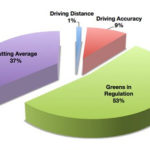Does Your Practice Swing Have a Purpose?
As I was watching the Haney Project tonight, Rush said something really profound that got me thinking. I decided to write about the subject of practice swings and how to actually perform them.
Do you take a practice swing by just swishing your club around in the air, kind of mindlessly looking around with no real purpose in mind? This is not a practice swing, but it can used to loosen you up a little bit before the shot, so it does have some value.
A real practice swing is one that simulates as closely as possible the swing you want to make when you are actually hitting the ball. You have a choice here, you can make this swing in slow motion, half speed or full speed, use whichever one gives you the best feedback and feel of the shot to be performed.
Those of you who swish the club around and call that a practice swing are wrong, this inattention to detail is a huge mistake. The practice swing is a great accelerator to improvement that we at Augusta Golf Instruction recommend to all of our students. An on-course practice swing is different than an on-range practice swing. The on-course practice swing is maybe one or two swings to get a feel for the motion you want to perform for that shot, the focus is on your target and the type of shot you want to hit leaving you in the best possible position for your next shot. The on-range practice swing is a completely different mindset; here you are working on making better body positioning movements during the swing. This is where you want to take your time, slow the process down, feel what you are changing. If you take 3 practice swings in slow motion for every ball you hit, think about how many more swings you have completed re-enforcing positive change. When you make two, three or more perfect practice swings, eventually your mind and body will catch on and you will transfer this effort to the ball, hitting better shots. The bottom line is this, if you can’t make good practice swings, how on earth do you expect to make a good swing when the ball is put into play. This is where logic pokes it’s head up, if you can’t do it slow, then you can’t do it fast, if you can’t do it on the range, then you can’t do it on the course, if you can’t do it on the first hole, then you can’t do it on the last hole when the pressure is the toughest.
At AGI, we develop a plan to help you achieve your goals, taking into account ability, time constraints, commitment and individual focus. It doesn’t matter as long as you know where to start, where you are headed and how many steps are involved in getting there. All this brings me back to the Haney Project and why this is important, Rush said in a fleeting moment that he made two hundred practice swings a day just focusing on what he was changing. He did not say he hit two hundred golf balls a day, just swings. So in conclusion, if you have a mirror and a half hour a day to commit to change, then you will accelerate your improvement faster than you ever thought possible.
AGI: play better golf.









